- Clone
- M1/70 (See other available formats)
- Regulatory Status
- RUO
- Other Names
- αM integrin, Mac-1, Mo1, CR3, Ly-40, C3biR, ITGAM
- Isotype
- Rat IgG2b, κ
- Ave. Rating
- Submit a Review
- Product Citations
- publications
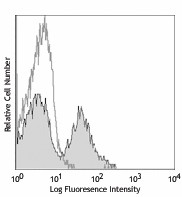
-

C57BL/6 mouse bone marrow cells were stained with Ultra-LEAF™ purified CD11b (clone M1/70) (filled histogram) or rat IgG2b, κ isotype control (open histogram), followed by anti-rat IgG FITC (gated on total cells).
CD11b is a 170 kD glycoprotein also known as αM integrin, Mac-1 α subunit, Mol, CR3, and Ly-40. CD11b is a member of the integrin family, primarily expressed on granulocytes, monocytes/macrophages, dendritic cells, NK cells, and subsets of T and B cells. CD11b non-covalently associates with CD18 (β2 integrin) to form Mac-1. Mac-1 plays an important role in cell-cell interaction by binding its ligands ICAM-1 (CD54), ICAM-2 (CD102), ICAM-4 (CD242), iC3b, and fibrinogen.
Product DetailsProduct Details
- Verified Reactivity
- Mouse, Human, Cynomolgus, Rhesus
- Reported Reactivity
- Chimpanzee, Baboon, Rabbit
- Antibody Type
- Monoclonal
- Host Species
- Rat
- Immunogen
- C57BL/10 splenocytes
- Formulation
- 0.2 µm filtered in phosphate-buffered solution, pH 7.2, containing no preservative.
- Endotoxin Level
- Less than 0.01 EU/µg of the protein (< 0.001 ng/µg of the protein) as determined by the LAL test.
- Preparation
- The Ultra-LEAF™ (Low Endotoxin, Azide-Free) antibody was purified by affinity chromatography.
- Concentration
- The antibody is bottled at the concentration indicated on the vial, typically between 2 mg/mL and 3 mg/mL. Older lots may have also been bottled at 1 mg/mL. To obtain lot-specific concentration and expiration, please enter the lot number in our Certificate of Analysis online tool.
- Storage & Handling
- The antibody solution should be stored undiluted between 2°C and 8°C. This Ultra-LEAF™ solution contains no preservative; handle under aseptic conditions.
- Application
-
FC - Quality tested
CyTOF® - Verified
IP, Block, Depletion, IHC-F, ICC - Reported in the literature, not verified in house - Recommended Usage
-
Each lot of this antibody is quality control tested by immunofluorescent staining with flow cytometric analysis. For flow cytometric staining, the suggested use of this reagent is ≤0.25 µg per million cells in 100 µl volume or 100 µl of whole blood. It is recommended that the reagent be titrated for optimal performance for each application.
- Application Notes
-
Clone M1/70 has been verified for immunocytochemistry (ICC) and frozen immunohistochemistry (IHC-F).
Additional reported applications (for relevant formats of this clone) include: immunoprecipitation1,4, in vitro blocking3,9,12, depletion2,8, immunofluorescence microscopy6,7,10, immunohistochemistry of acetone-fixed frozen sections5,11-13, and spatial biology (IBEX)35,36. For in vivo studies or highly sensitive assays, we recommend Ultra-LEAF™ purified antibody (Endotoxin < 0.01 EU/µg, Azide-Free, 0.2 µm filtered) (Cat. No. 101248). -
Application References
(PubMed link indicates BioLegend citation) -
- Springer T, et al. 1978. Eur. J. Immunol. 8:539. (IP)
- Ault K and Springer T. 1981. J. Immunol. 126:359. (Deplete)
- Springer TA, et al. 1982. Immunol. Rev. 68:171. (Block)
- Ho MK and Springer TA. 1983. J. Biol. Chem. 258:2766. (IP)
- Flotte TJ, et al. 1983. Am. J. Pathol. 111:112. (IHC)
- Noel GJ, et al. 1990. J. Clin. Invest. 85:208. (IF)
- Allen LA and Aderem A. 1996. J. Exp. Med. 184:627 (IF)
- D'Amico A and Wu L. 2003. J. Exp. Med. 198:293. (Deplete)
- Brickson SJ, et al. 2003. Appl Physiol. 95:969. (Block)
- Clatworthy MR and Smith KG. 2004. J. Exp. Med. 199:717. (IF)
- Hata H, et al. 2004. J. Clin. Invest. 114:582. (IHC)
- Zhang Y, et al. 2002. J. Immunol. 168:3088. (IHC)
- Iwasaki A and Kelsall BL. 2001. J. Immunol. 166:4884 (IHC, FC)
- Tailleux L. 2003. J. Exp. Med. 197:121. (Block, FC)
- Olver S, et al. 2006. Cancer Research 66:571. (FC)
- Tan SL, et al. 2006. J. Immunol. 176:2872. (FC) PubMed
- Ponomarev ED, et al. 2006. J. Immunol. 176:1402. (FC)
- Dzhagalov I, et al. 2007. Blood 109:1620. (FC)
- Fazilleau N, et al. 2007. Nature Immunol. 8:753.
- Rasmussen JW, et al. 2006. Infect. Immun.74:6590. PubMed
- Napimoga MH, et al. 2008. J. Immunol. 180:609. PubMed
- Elqaraz-Carmon V, et al. 2008. J. Lipid. Res. 49:1894. PubMed
- Kim DD, et al. 2008. Blood 112:1109. PubMed
- Guo Y, et al. 2008. Blood 112:480. PubMed
- Norian LA, et al. 2009. Cancer Res. 69:3086. (FC) PubMed
- Baumgartner CK, et al. 2010. J. Immunol. 184:573. PubMed
- Charles N, et al. 2010. Nat. Med. 16:701. (FC) PubMed
- Whiteland J, et al. 1995. J. Histochem. Cytochem. 43:313. (IHC)
- Weber GF, et al. 2014. J Exp Med. 211:1243. PubMed
- Ashok A, et al. 2015. Toxicol Sci. 143:64. PubMed
- Price PJ, et al. 2015. J Immunol. 194:1164. PubMed
- Doni A, et al. 2015. J Exp Med. 212:905. PubMed
- Ferreira R, et al. 2016. J Infect Dis. 213: 669 - 673. PubMed
- Peterson VM, et al. 2017. Nat. Biotechnol. 35:936. (PG)
- Radtke AJ, et al. 2020. Proc Natl Acad Sci U S A. 117:33455-65. (SB) PubMed
- Radtke AJ, et al. 2022. Nat Protoc. 17:378-401. (SB) PubMed
- Product Citations
-
- RRID
-
AB_2813917 (BioLegend Cat. No. 101247)
AB_2561479 (BioLegend Cat. No. 101248)
AB_2813918 (BioLegend Cat. No. 101269)
AB_2813919 (BioLegend Cat. No. 101270)
AB_2813920 (BioLegend Cat. No. 101271)
AB_2813921 (BioLegend Cat. No. 101272)
Antigen Details
- Structure
- Integrin family, associates with integrin β2 (CD18), 170 kD
- Distribution
-
Granulocytes, monocytes/macrophages, dendritic cells, NK cells, subsets of T and B cells
- Function
- Adhesion, chemotaxis
- Ligand/Receptor
- ICAM-1 (CD54), ICAM-2 (CD102), ICAM-4 (CD242), iC3b, fibrinogen
- Cell Type
- B cells, Dendritic cells, Granulocytes, Macrophages, Monocytes, Neutrophils, NK cells, T cells, Tregs
- Biology Area
- Cell Adhesion, Cell Biology, Costimulatory Molecules, Immunology, Innate Immunity, Neuroscience, Neuroscience Cell Markers
- Molecular Family
- Adhesion Molecules, CD Molecules
- Antigen References
-
1. Barclay A, et al. 1997. The Leukocyte Antigen FactsBook Academic Press.
2. Springer TA. 1994. Cell 76:301.
3. Coxon A, et al. 1996. Immunity 5:653. - Gene ID
- 16409 View all products for this Gene ID 3684 View all products for this Gene ID
- UniProt
- View information about CD11b on UniProt.org
Related FAQs
- Do you guarantee that your antibodies are totally pathogen free?
-
BioLegend does not test for pathogens in-house aside from the GoInVivo™ product line. However, upon request, this can be tested on a custom basis with an outside, independent laboratory.
- Does BioLegend test each Ultra-LEAF™ antibody by functional assay?
-
No, BioLegend does not test Ultra-LEAF™ antibodies by functional assays unless otherwise indicated. Due to the possible complexities and variations of uses of biofunctional antibodies in different assays and because of the large product portfolio, BioLegend does not currently perform functional assays as a routine QC for the antibodies. However, we do provide references in which the antibodies were used for functional assays and we do perform QC to verify the specificity and quality of the antibody based on our strict specification criteria.
- Does BioLegend test each Ultra-LEAF™ antibody for potential pathogens?
-
No, BioLegend does not test for pathogens in-house unless otherwise indicated. However, we can recommend an outside vendor to perform this testing as needed.
- Have you tested this Ultra-LEAF™ antibody for in vivo or in vitro applications?
-
We don't test our antibodies for in vivo or in vitro applications unless otherwise indicated. Depending on the product, the TDS may describe literature supporting usage of a particular product for bioassay. It may be best to further consult the literature to find clone specific information.
Other Formats
View All CD11b Reagents Request Custom ConjugationCustomers Also Purchased
Compare Data Across All Formats
This data display is provided for general comparisons between formats.
Your actual data may vary due to variations in samples, target cells, instruments and their settings, staining conditions, and other factors.
If you need assistance with selecting the best format contact our expert technical support team.
-
APC anti-mouse/human CD11b

C57BL/6 mouse bone marrow cells were stained with CD11b (clo... -
Biotin anti-mouse/human CD11b
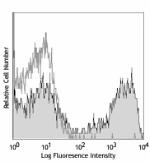
C57BL/6 mouse bone marrow cells were stained with biotinylat... -
FITC anti-mouse/human CD11b
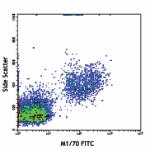
C57BL/6 mouse bone marrow cells were stained with CD11b (clo... 
-
PE anti-mouse/human CD11b
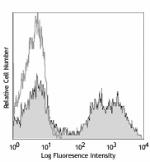
C57BL/6 mouse bone marrow cells were stained with CD11b (clo... 
Fixed whole mount mouse spleen was stained with Alexa Fluor®... -
PE/Cyanine5 anti-mouse/human CD11b

C57BL/6 mouse bone marrow cells stained with CD11b (clone M1... -
Purified anti-mouse/human CD11b
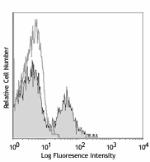
C57BL/6 mouse bone marrow cells were stained with purified C... 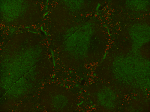
Fresh, frozen mouse spleen was stained with purified CD11b c... -
PE/Cyanine7 anti-mouse/human CD11b
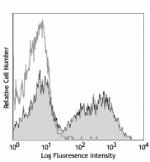
C57BL/6 mouse bone marrow cells were stained with CD11b (clo... -
Alexa Fluor® 488 anti-mouse/human CD11b
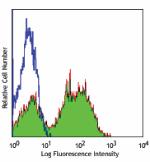
C57BL/6 mouse bone marrow cells were stained with CD11b (clo... 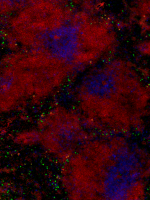
C57BL/6 mouse frozen spleen section was fixed with 4% parafo... 
Paraformaldehyde-fixed (1%), 500 µm-thick mouse spleen secti... 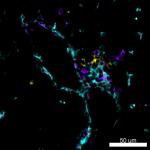
Confocal image of C57BL/6 mouse liver sample acquired using ... -
Alexa Fluor® 647 anti-mouse/human CD11b

C57BL/6 mouse bone marrow cells were stained with CD11b (clo... 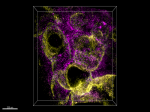
Paraformaldehyde-fixed (4%), 500 µm-thick mouse spleen secti... -
Alexa Fluor® 700 anti-mouse/human CD11b

C57BL/6 mouse bone marrow cells were stained with CD11b (clo... -
Pacific Blue™ anti-mouse/human CD11b

C57BL/6 mouse bone marrow cells were stained with CD11b (clo... -
APC/Cyanine7 anti-mouse/human CD11b
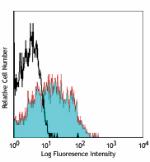
C57BL/6 mouse bone marrow stained with M1/70 APC/Cyanine7 -
PerCP/Cyanine5.5 anti-mouse/human CD11b

C57BL/6 splenocytes were blocked with TruStain FcX™ (a... -
PerCP anti-mouse/human CD11b

C57BL/6 mouse bone marrow cells were stained with CD11b (clo... -
Brilliant Violet 421™ anti-mouse/human CD11b
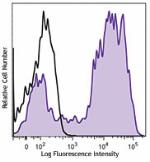
C57BL/6 mouse bone marrow cells were stained with CD11b (clo... 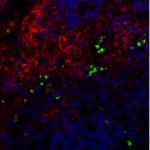
BL/6 mouse lymph nodes, fixed O/N in PLP, blocked with 10% r... -
Brilliant Violet 570™ anti-mouse/human CD11b

C57BL/6 mouse bone marrow cells were stained with CD11b (clo... -
Brilliant Violet 605™ anti-mouse/human CD11b

C57BL/6 mouse bone marrow cells were stained with CD11b (clo... -
Brilliant Violet 650™ anti-mouse/human CD11b
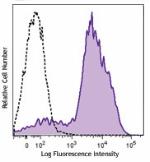
C57BL/6 mouse bone marrow cells were stained with CD11b (clo... -
Brilliant Violet 711™ anti-mouse/human CD11b
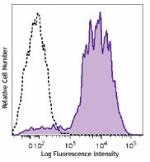
C57BL/6 mouse bone marrow cells were stained with CD11b (clo... -
Brilliant Violet 785™ anti-mouse/human CD11b
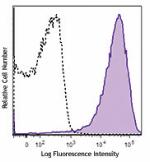
C57BL/6 mouse bone marrow cells were stained with CD11b (clo... -
Brilliant Violet 510™ anti-mouse/human CD11b
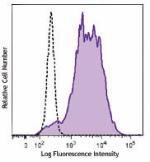
C57BL/6 mouse bone marrow cells were stained with CD11b (clo... 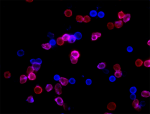
C57 mouse bone marrow cells were fixed with 2% paraformaldeh... -
Ultra-LEAF™ Purified anti-mouse/human CD11b

C57BL/6 mouse bone marrow cells were stained with Ultra-LEAF... -
Purified anti-mouse/human CD11b (Maxpar® Ready)

Mouse splenocytes stained with 172Yb-anti-CD11b (M1/70) and ... -
Alexa Fluor® 594 anti-mouse/human CD11b
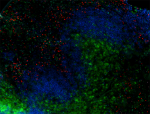
C57BL/6 mouse frozen spleen section was fixed with 4% parafo... 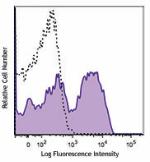
C57BL/6 mouse bone marrow cells were stained with CD11b (clo... -
PE/Dazzle™ 594 anti-mouse/human CD11b
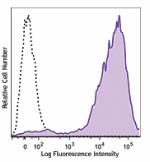
C57BL/6 mouse bone marrow cells were stained with CD11b (clo... -
APC/Fire™ 750 anti-mouse/human CD11b
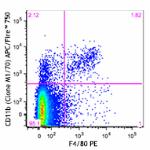
C57BL/6 splenocytes were blocked with TruStain fcX™ (a... 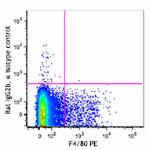
-
TotalSeq™-A0014 anti-mouse/human CD11b
-
Brilliant Violet 750™ anti-mouse/human CD11b

C57BL/6 mouse bone marrow cells were stained with Ly-6G/Ly-6... -
TotalSeq™-B0014 anti-mouse/human CD11b
-
TotalSeq™-C0014 anti-mouse/human CD11b
-
Spark NIR™ 685 anti-mouse/human CD11b

C57BL/6 splenocytes were stained with Ly-6G/Ly-6C (Gr-1) Pac... -
PE/Fire™ 640 anti-mouse/human CD11b

C57BL/6 mouse bone marrow cells were stained with anti-mouse... -
Spark YG™ 593 anti-mouse/human CD11b

C57BL/6 mouse bone marrow cells were stained with Ly-6G/Ly-6... -
Spark YG™ 570 anti-mouse/human CD11b

C57BL/6 mouse frozen spleen section was fixed with 4% parafo... -
PE/Fire™ 810 anti-mouse/human CD11b

C57BL/6 mouse bone marrow cells were stained with anti-mouse... -
APC/Fire™ 810 anti-mouse/human CD11b Antibody

C57BL/6 mouse bone marrow cells were stained with anti-mouse... -
Spark Blue™ 550 anti-mouse/human CD11b
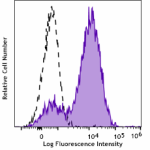
C57BL/6 mouse bone marrow cells were stained with anti-mouse... -
Spark UV™ 387 anti-mouse/human CD11b

C57BL/6 bone marrow cells were stained with anti-mouse Ly-6G... -
PerCP/Fire™ 806 anti-mouse/human CD11b

C57BL/6 mouse bone marrow cells were stained with anti-mouse... -
PerCP/Fire™ 780 anti-mouse/human CD11b

C57BL/6 mouse bone marrow cells were stained with anti-mouse... -
Spark Blue™ 574 anti-mouse/human CD11b (Flexi-Fluor™)
-
Spark PLUS UV™ 395 anti-mouse/human CD11b

C57BL/6 mouse splenocytes were stained with anti-mouse Ly-6G...
 Login / Register
Login / Register 














Follow Us